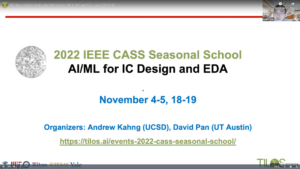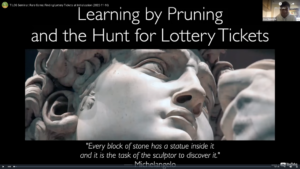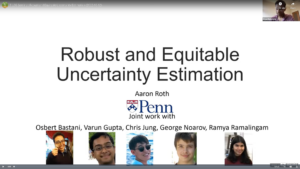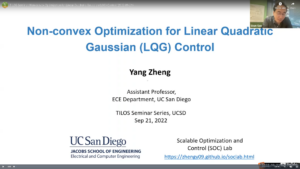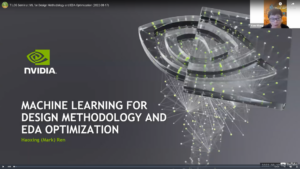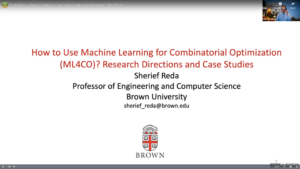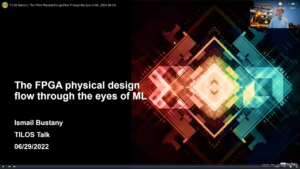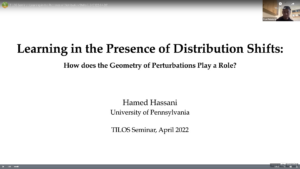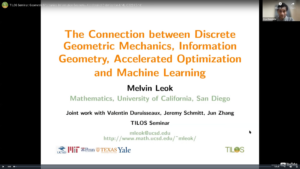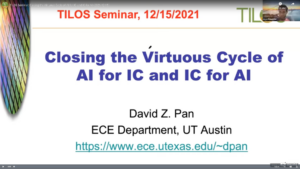Recorded Talks: Machine Learning
IEEE Seasonal School: Standard Platforms for ML in EDA and IC Design
00:00:00 - Introduction
00:02:45 - "Exchanging EDA data for AI/ML using Standard API", Kerim Kalafala, Senior Technical Staff Member, IBM (co-chair, AI/ML for EDA Special Interest Group, Si2), Richard Taggart, Senior Software Engineering Manager, IBM and Akhilesh Kumar, Principal R&D Engineer, Ansys
01:29:30 - "IEEE CEDA DATC RDF and METRICS2.1: Toward a Standard Platform for ML-Enabled EDA and IC Design", Jinwook Jung, Research Staff Member, IBM Research
TILOS Seminar: Rare Gems: Finding Lottery Tickets at Initialization
Dimitris Papailiopoulos, Associate Professor, University of Wisconsin-Madison
Large neural networks can be pruned to a small fraction of their original size, with little loss in accuracy, by following a time-consuming “train, prune, re-train” approach. Frankle & Carbin in 2019 conjectured that we can avoid this by training lottery tickets, i.e., special sparse subnetworks found at initialization, that can be trained to high accuracy. However, a subsequent line of work presents concrete evidence that current algorithms for finding trainable networks at initialization, fail simple baseline comparisons, e.g., against training random sparse subnetworks. Finding lottery tickets that train to better accuracy compared to simple baselines remains an open problem. In this work, we resolve this open problem by discovering Rare Gems: sparse, trainable networks at initialization, that achieve high accuracy even before training. When Rare Gems are trained with SGD, they achieve accuracy competitive or better than Iterative Magnitude Pruning (IMP) with warmup.
Dimitris Papailiopoulos is the Jay & Cynthia Ihlenfeld Associate Professor of Electrical and Computer Engineering at the University of Wisconsin-Madison, a faculty fellow of the Grainger Institute for Engineering, and a faculty affiliate at the Wisconsin Institute for Discovery. His research interests span machine learning, information theory, and distributed systems, with a current focus on efficient large-scale training algorithms. Before coming to Madison, Dimitris was a postdoctoral researcher at UC Berkeley and a member of the AMPLab. He earned his Ph.D. in ECE from UT Austin, under the supervision of Alex Dimakis. He received his ECE Diploma M.Sc. degree from the Technical University of Crete, in Greece. Dimitris is a recipient of the NSF CAREER Award (2019), three years of Sony Faculty Innovation Awards (2018, 2019 and 2020), a joint IEEE ComSoc/ITSoc Best Paper Award (2020), an IEEE Signal Processing Society, Young Author Best Paper Award (2015), the Vilas Associate Award (2021), the Emil Steiger Distinguished Teaching Award (2021), and the Benjamin Smith Reynolds Award for Excellence in Teaching (2019). In 2018, he co-founded MLSys, a new conference that targets research at the intersection of machine learning and systems.
IEEE Seasonal School: Applications / Future Frontiers
00:00:00 - Introduction
01:23:00 - "Automating Analog Layout: Why This Time is Different", Sachin Sapatnekar, Professor, University of Minnesota
57:20:00 - "Machine Learning-Powered Tools and Methodologies for 3D Integration", Sung Kyu Lim, Professor, Georgia Institute of Technology
01:58:18 - "ML for Verification", Shobha Vasudevan, Researcher at Google and Adjunct Professor at UIUC
IEEE Seasonal School: Deep / Reinforcement Learning
00:00:00 - Introduction
02:30:00 - "Machine Learning for EDA Optimization", Mark Ren, Senior Manager, NVIDIA Research
01:02:30 - "Learning to Optimize", Ismail Bustany, Fellow, AMD
02:01:50 - "Circuit Training: An open-source framework for generating chip floor plans with distributed deep reinforcement learning", Joe Jiang, Staff Software Engineer and Manager, Google Brain
TILOS Seminar: Robust and Equitable Uncertainty Estimation
Aaron Roth, Professor, University of Pennsylvania
Machine learning provides us with an amazing set of tools to make predictions, but how much should we trust particular predictions? To answer this, we need a way of estimating the confidence we should have in particular predictions of black-box models. Standard tools for doing this give guarantees that are averages over predictions. For instance, in a medical application, such tools might paper over poor performance on one medically relevant demographic group if it is made up for by higher performance on another group. Standard methods also depend on the data distribution being static—in other words, the future should be like the past.
In this lecture, I will describe new techniques to address both these problems: a way to produce prediction sets for arbitrary black-box prediction methods that have correct empirical coverage even when the data distribution might change in arbitrary, unanticipated ways and such that we have correct coverage even when we zoom in to focus on demographic groups that can be arbitrary and intersecting. When we just want correct group-wise coverage and are willing to assume that the future will look like the past, our algorithms are especially simple.
This talk is based on two papers that are joint work with Osbert Bastani, Varun Gupta, Chris Jung, Georgy Noarov, and Ramya Ramalingam.
Aaron Roth is the Henry Salvatori Professor of Computer and Cognitive Science, in the Computer and Information Sciences department at the University of Pennsylvania, with a secondary appointment in the Wharton statistics department. He is affiliated with the Warren Center for Network and Data Science, and co-director of the Networked and Social Systems Engineering (NETS) program. He is also an Amazon Scholar at Amazon AWS. He is the recipient of a Presidential Early Career Award for Scientists and Engineers (PECASE) awarded by President Obama in 2016, an Alfred P. Sloan Research Fellowship, an NSF CAREER award, and research awards from Yahoo, Amazon, and Google. His research focuses on the algorithmic foundations of data privacy, algorithmic fairness, game theory, learning theory, and machine learning. Together with Cynthia Dwork, he is the author of the book “The Algorithmic Foundations of Differential Privacy.” Together with Michael Kearns, he is the author of “The Ethical Algorithm.”
TILOS Seminar: Non-convex Optimization for Linear Quadratic Gaussian (LQG) Control
Yang Zheng, Assistant Professor, UC San Diego
Recent studies have started to apply machine learning techniques to the control of unknown dynamical systems. They have achieved impressive empirical results. However, the convergence behavior, statistical properties, and robustness performance of these approaches are often poorly understood due to the non-convex nature of the underlying control problems. In this talk, we revisit the Linear Quadratic Gaussian (LQG) control and present recent progress towards its landscape analysis from a non-convex optimization perspective. We view the LQG cost as a function of the controller parameters and study its analytical and geometrical properties. Due to the inherent symmetry induced by similarity transformations, the LQG landscape is very rich yet complicated. We show that 1) the set of stabilizing controllers has at most two path-connected components, and 2) despite the nonconvexity, all minimal stationary points (controllable and observable controllers) are globally optimal. Based on the special non-convex optimization landscape, we further introduce a novel perturbed policy gradient (PGD) method to escape a large class of suboptimal stationary points (including high-order saddles). These results shed some light on the performance analysis of direct policy gradient methods for solving the LQG problem. The talk is based on our recent papers: https://arxiv.org/abs/2102.04393 and https://arxiv.org/abs/2204.00912.
Yang Zheng is an assistant professor in the ECE department at UC San Diego. Yang Zheng received the DPhil (Ph.D.) degree in Engineering Science from the University of Oxford in 2019. He received the B.E. and M.S. degrees from Tsinghua University in 2013 and 2015, respectively. From February 2019 to August 2020, he was a postdoctoral researcher at Harvard University. He was a research associate at Imperial College London in 2021.
Dr. Zheng’s research interests include learning, optimization, and control of network systems, and their applications to cyber-physical systems, autonomous vehicles, and traffic systems. His work has been acknowledged by several awards, including the 2019 European Ph.D. Award on Control for Complex and Heterogeneous Systems, the Best Student Paper Award Finalist at the 2019 European Control Conference, the Best Student Paper Award at the 17th IEEE International Conference on Intelligent Transportation Systems, and the Best Paper Award at the 14th Intelligent Transportation Systems Asia-Pacific Forum. He received the National Scholarship, Outstanding Graduate at Tsinghua University, the Clarendon Scholarship at the University of Oxford, and the Chinese Government Award for Outstanding Self-financed Students Abroad.
TILOS Seminar: Machine Learning for Design Methodology and EDA Optimization
Haoxing Ren, NVIDIA
In this talk, I will first illustrate how ML helps improve design quality as well as design productivity from design methodology perspective with examples in digital and analog designs. Then I will discuss the potential of applying ML to solve challenging EDA optimization problems, focusing on three promising ML techniques: reinforcement learning (RL), physics-based modeling and self-supervised learning (SSL). RL learns to optimize the problem by converting the EDA problem objectives into environment rewards. It can be applied to both directly solve the EDA problem or be part of a conventional EDA algorithm. Physics-based modeling enables more accurate and transferable learning for EDA problems. SSL learns the optimized EDA solution data manifold. Conditioned on the problem input, it can directly produce the solution. I will illustrate the applications of these techniques in standard cell layout, computational lithography, and gate sizing problems. Finally, I will outline three main approaches to integrate ML and conventional EDA algorithms together and the importance of adopting GPU computing to EDA.
Haoxing Ren (Mark) leads the Design Automation research group at NVIDIA Research. His research interests are machine learning applications in design automation and GPU accelerated EDA. Before joining NVIDIA in 2016, he spent 15 years at IBM Microelectronics and IBM Research working on physical design and logic synthesis tools and methodologies for IBM microprocessor and ASIC designs. He received several IBM technical achievement awards including the IBM Corporate Award for his work on improving microprocessor design productivity. He published many papers in the field of design automation including several book chapters in logic synthesis and physical design. He also received the best paper awards at ISPD’2013, DAC’2019 and TCAD’2021. He earned his PhD in Computer Engineering from University of Texas at Austin in 2006.
TILOS Seminar: How to use Machine Learning for Combinatorial Optimization
Sherief Reda, Professor, Brown University and Principal Research Scientist at Amazon
Combinatorial optimization methods are routinely used in many scientific fields to identify optimal solutions among a large but finite set of possible solutions for problems of interests. Given the recent success of machine learning techniques in classification of natural signals (e.g., voice, image, text), it is natural to ask how machine learning methods can be used to improve the quality of solution or the runtime of combinatorial optimization algorithms? In this talk I will provide a general taxonomy and research directions for the use of machine learning techniques in combinatorial optimization. I will illustrate these directions using a number of case studies from my group's research, which include (1) improving the quality of results of integer linear programming (ILP) solver using deep metric learning, and (2) using reinforcement learning techniques to optimize the size of graphs arising in digital circuit design.
Sherief Reda is a Full Professor at the School of Engineering and Computer Science Department at Brown University and a Principal Research Scientist at Amazon. He joined Brown University in 2006 after receiving his Ph.D. in computer science and engineering from University of California, San Diego. He has over 135 research articles in the areas of energy-efficient computing, electronic design automation and combinatorial optimization, as well as several patents. Professor Reda received a number of research acknowledgments and awards, including eight best paper nominations, three best paper awards, and a National Science Foundation CAREER award. He has been a PI or co-PI on more than $21.1M of funded projects from federal agencies and industry corporations. He is a senior member of IEEE.
The FPGA Physical Design Flow Through the Eyes of Machine Learning
Dr. Ismail Bustany, Fellow, AMD
The FPGA physical design (PD) flow has innate features that differentiate it from its sibling, the ASIC PD flow. FPGA device families service a wide range of applications, have much longer lifespans in production use, and bring templatized logic layout and routing interconnect fabrics whose characteristics are captured by detailed device models and simpler timing and routing models (e.g. buffered interconnect and abstracted routing resources). Furthermore, the FPGA PD flow is a “one-stop shop” from synthesis to bitstream generation. This avails complete access to annotate, instrument, and harvest netlist and design features. These key differences provide rich opportunities to exploit both device data and design application specific contexts in optimizing various components of the PD flow. In this talk, I will present examples for the application of ML in device modeling and parameter optimization, draw attention to exciting research opportunities for applying the “learning to optimize” paradigm to solving the placement and routing problems, and share some practical learnings.
Dr. Ismail Bustany is a Fellow at AMD, where he works on physical design implementation and MLCAD . He has served on the technical program committees for the ISPD, ISQED, and DAC. He was the 2019 ISPD general chair. He currently serves on the organizing committees for the ICCAD and SLIP. He organized the 2014 and 2015 ISPD detailed routing-driven placement contests and co-organized the 2017 ICCAD detailed placement contest. His research interests include physical design, computationally efficient optimization algorithms, MLCAD, sparse matrix computations/acceleration, and partitioning algorithms. He earned his B.S. in CSE from UC San Diego and M.S./Ph.D. in EECS from UC Berkeley.
TILOS Seminar: Learning in the Presence of Distribution Shifts: How does the Geometry of Perturbations Play a Role?
Hamed Hassani, Assistant Professor, University of Pennsylvania
In this talk, we will focus on the emerging field of (adversarially) robust machine learning. The talk will be self-contained and no particular background on robust learning will be needed. Recent progress in this field has been accelerated by the observation that despite unprecedented performance on clean data, modern learning models remain fragile to seemingly innocuous changes such as small, norm-bounded additive perturbations. Moreover, recent work in this field has looked beyond norm-bounded perturbations and has revealed that various other types of distributional shifts in the data can significantly degrade performance. However, in general our understanding of such shifts is in its infancy and several key questions remain unaddressed.
The goal of this talk is to explain why robust learning paradigms have to be designed—and sometimes rethought—based on the geometry of the input perturbations. We will cover a wide range of perturbation geometries from simple norm-bounded perturbations, to sparse, natural, and more general distribution shifts. As we will show, the geometry of the perturbations necessitates fundamental modifications to the learning procedure as well as the architecture in order to ensure robustness. In the first part of the talk, we will discuss our recent theoretical results on robust learning with respect to various geometries, along with fundamental tradeoffs between robustness and accuracy, phase transitions, etc. The remaining portion of the talk will be about developing practical robust training algorithms and evaluating the resulting (robust) deep networks against state-of-the-art methods on naturally-varying, real-world datasets.
TILOS Seminar: The Connections Between Discrete Geometric Mechanics, Information Geometry, Accelerated Optimization and Machine Learning
Melvin Leok, Professor of Mathematics, UC San Diego
Geometric mechanics describes Lagrangian and Hamiltonian mechanics geometrically, and information geometry formulates statistical estimation, inference, and machine learning in terms of geometry. A divergence function is an asymmetric distance between two probability densities that induces differential geometric structures and yields efficient machine learning algorithms that minimize the duality gap. The connection between information geometry and geometric mechanics will yield a unified treatment of machine learning and structure-preserving discretizations. In particular, the divergence function of information geometry can be viewed as a discrete Lagrangian, which is a generating function of a symplectic map, that arise in discrete variational mechanics. This identification allows the methods of backward error analysis to be applied, and the symplectic map generated by a divergence function can be associated with the exact time-h flow map of a Hamiltonian system on the space of probability distributions. We will also discuss how time-adaptive Hamiltonian variational integrators can be used to discretize the Bregman Hamiltonian, whose flow generalizes the differential equation that describes the dynamics of the Nesterov accelerated gradient descent method.
Melvin Leok is professor of mathematics and co-director of the CSME graduate program at the UC San Diego. His research interests are in computational geometric mechanics, computational geometric control theory, discrete geometry, and structure-preserving numerical schemes, and particularly how these subjects relate to systems with symmetry. He received his Ph.D. in 2004 from the California Institute of Technology in Control and Dynamical Systems under the direction of Jerrold Marsden. He is a three-time NAS Kavli Frontiers of Science Fellow, a Simons Fellow in Mathematics, and has received the DoD Newton Award for Transformative Ideas, the NSF Faculty Early Career Development (CAREER) award, the SciCADE New Talent Prize, the SIAM Student Paper Prize, and the Leslie Fox Prize (second prize) in Numerical Analysis. He has given plenary talks at Foundations of Computational Mathematics, NUMDIFF, and the IFAC Workshop on Lagrangian and Hamiltonian Methods for Nonlinear Control. He serves on the editorial boards of the Journal of Nonlinear Science, the Journal of Geometric Mechanics, and the Journal of Computational Dynamics, and has served on the editorial boards of the SIAM Journal on Control and Optimization, and the LMS Journal of Computation and Mathematics.
TILOS Seminar: Closing the Virtuous Cycle of AI for IC and IC for AI
David Pan, Professor, University of Texas at Austin
The recent artificial intelligence (AI) boom has been primarily driven by three confluence forces: algorithms, big-data, and computing power enabled by modern integrated circuits (ICs), including specialized AI accelerators. This talk will present a closed-loop perspective for synergistic AI and agile IC design with two main themes, AI for IC and IC for AI. As semiconductor technology enters the era of extreme scaling and heterogeneous integration, IC design and manufacturing complexities become extremely high. More intelligent and agile IC design technologies are needed than ever to optimize performance, power, manufacturability, design cost, etc., and deliver equivalent scaling to Moore’s Law. This talk will present some recent results leveraging modern AI and machine learning advancement with domain-specific customizations for agile IC design and manufacturing, including open-sourced DREAMPlace (DAC’19 and TCAD’21 Best Paper Awards), DARPA-funded MAGICAL project for analog IC design automation, and LithoGAN for design-technology co-optimization. Meanwhile on the IC for AI frontier, customized ICs, including those with beyond-CMOS technologies, can drastically improve AI performance and energy efficiency by orders of magnitude. I will present our recent results on hardware and software co-design for optical neural networks and photonic ICs (which won the 2021 ACM Student Research Competition Grand Finals 1st Place). Closing the virtuous cycle between AI and IC holds great potential to significantly advance the state-of-the-art of each other.

